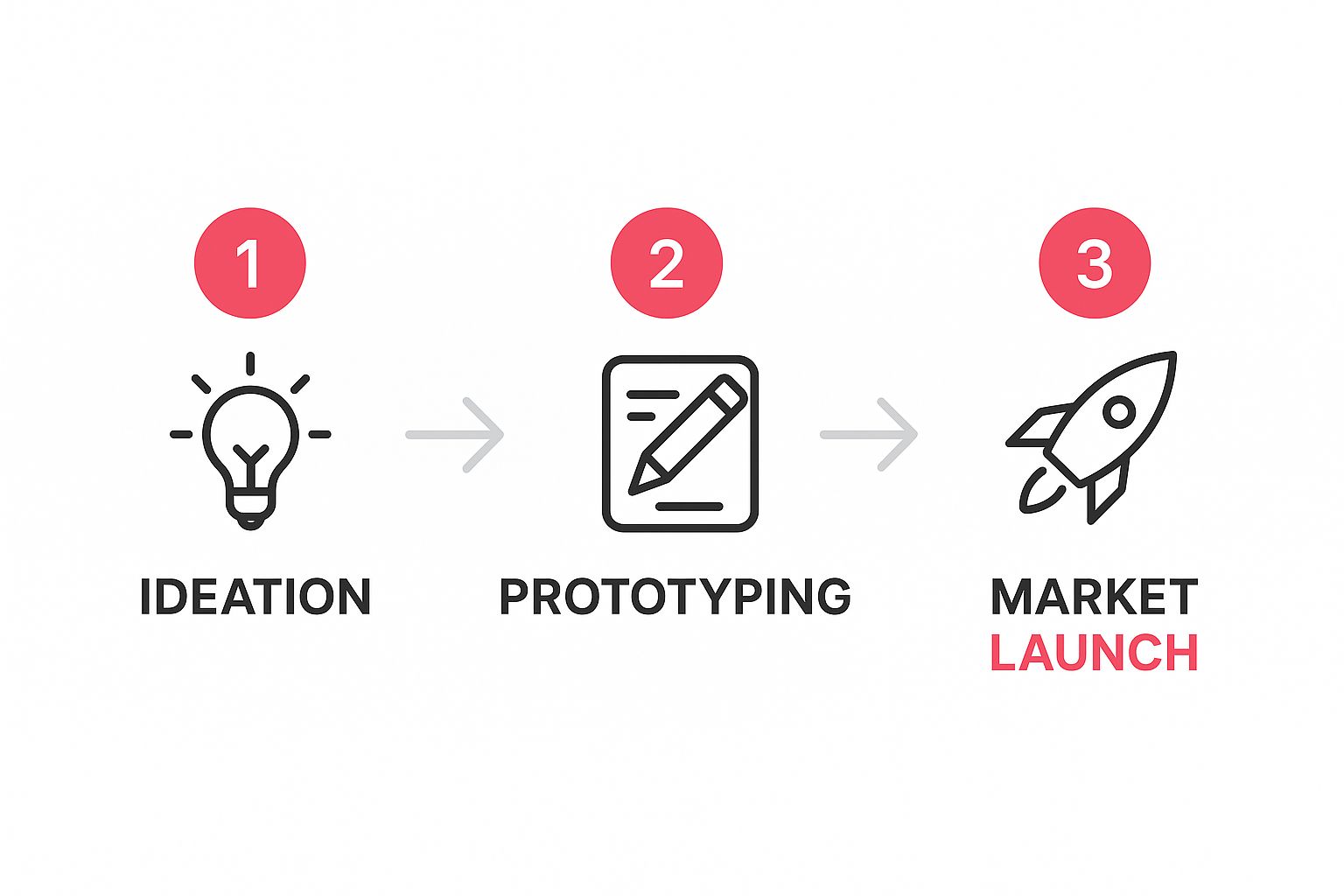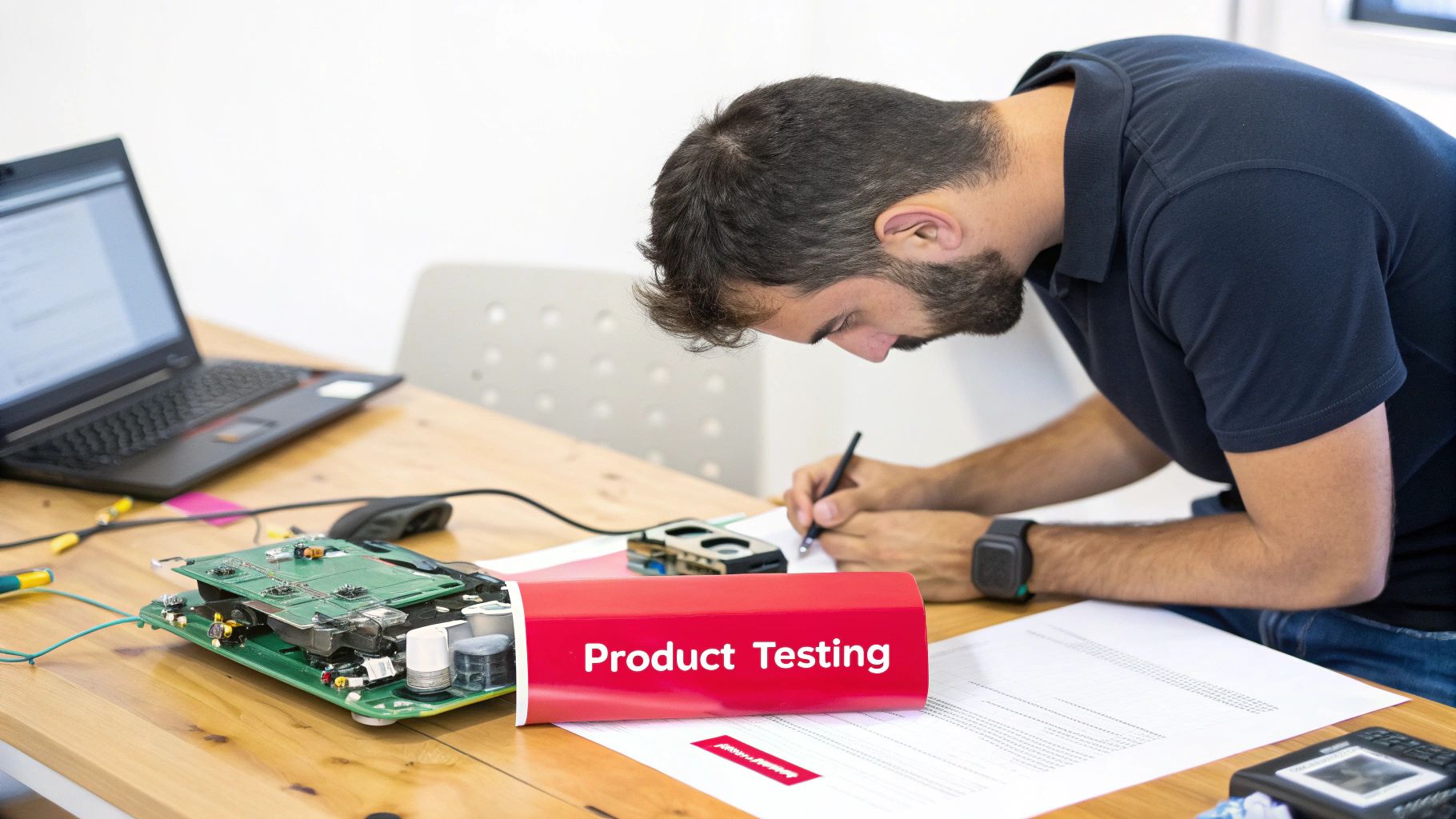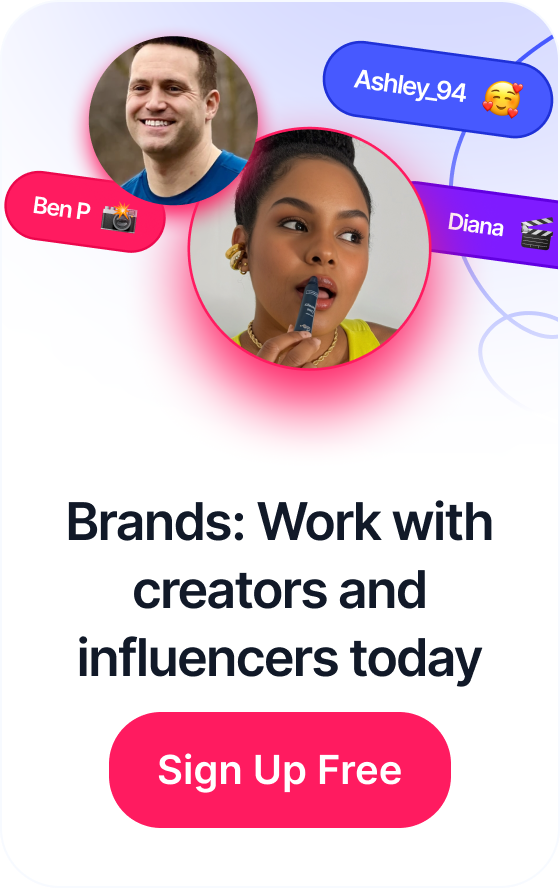 12 Best Content Calendar Template Resources for 2025
12 Best Content Calendar Template Resources for 2025
A successful product launch isn't just a single event. It's really a strategic mission broken down into three core phases: pre-launch planning, launch day execution, and post-launch analysis. When you treat it like a blueprint, every single step—from that first spark of an idea to getting real market feedback—is deliberate and measured. This dramatically boosts your odds of making a real impact.
Table of Contents
Your Blueprint For A Successful Product Launch
Let's be honest: launching a new product can feel like a high-stakes bet, because it is. That journey from a great idea to a product people love is full of twists and turns. It absolutely requires a clear, structured plan to keep you on track.
Without a solid framework, it's easy for teams to lose focus, miss out on golden opportunities, and just burn through cash with little to show for it. That's why thinking of the whole process as a sequential blueprint is so crucial.
For a lot of new products, especially those sold online, a key piece of that blueprint is knowing how to launch a Shopify store effectively. Getting that initial setup right becomes the foundation of your digital-first strategy.
The Three Pillars Of A Product Launch
Your strategic map is built on three fundamental pillars. Each phase has its own set of goals and activities that build on the last one, creating momentum and making sure no detail gets missed.
- Pre-Launch Planning: This is where the real work happens and where success is truly made. It's all about deep market research, getting crystal clear on your ideal customer, and setting objectives (KPIs) you can actually measure. This is when you answer the who, what, why, and how of your entire launch.
- Launch Execution: This phase is all about making the biggest splash possible. It involves the coordinated rollout of your marketing campaigns, firing up your influencer partnerships, and making sure your sales and support teams are ready for the wave of new customers.
- Post-Launch Analysis: The job isn't done when the launch day ends. This final phase is about digging into the data, seeing how you performed against your KPIs, and gathering customer feedback. The insights you get here are pure gold for future product updates and marketing tweaks.
Here’s a quick overview of how these phases fit together to create a structured launch plan.
Core Phases of a Product Launch
This table breaks down the three essential stages of a product launch, outlining their main goals and the key tasks involved. It’s a simple way to visualize the structured approach needed for success.
| Launch Phase | Primary Objective | Critical Activities |
|---|---|---|
| Pre-Launch Planning | Build a solid foundation and generate initial buzz. | Market research, defining target audience, setting KPIs, content creation, influencer outreach. |
| Launch Execution | Maximize visibility and drive initial sales. | Coordinated marketing campaigns, press releases, influencer activation, website and sales channel go-live. |
| Post-Launch Analysis | Measure success and gather insights for optimization. | Tracking KPIs, collecting customer feedback, analyzing sales data, planning future product updates. |
Following these distinct phases ensures that your efforts are focused and build upon each other, leading to a much stronger market entry.
The hard truth is that blockbuster success is both rare and expensive. Only about 3% of new products break $50 million in first-year sales, and the average launch costs a whopping $15 million. A major reason for failure? A staggering 42% of startups admit to building products that don't solve a real customer problem.
The process flow below visualizes this core progression, taking you from that initial concept all the way to a market-ready product.

This just goes to show that a successful launch is never an isolated event. It's the grand finale of a structured, multi-stage journey. By following this kind of roadmap, you ensure that your product isn't just well-built, but also perfectly positioned to win in the market.
Building Your Pre-Launch Foundation
A product launch's fate is often sealed long before anyone clicks "buy." This is the foundational stage—the behind-the-scenes work where you turn a great idea into a rock-solid, actionable plan. A killer market entry isn't about getting lucky; it's about meticulous prep work and knowing your market inside and out.
Think of it like building a house. You wouldn't just start throwing up drywall without first pouring a solid foundation. Skipping these early steps in a product launch is just as dangerous and almost guarantees things will crumble later.

Uncovering Market Realities and Opportunities
First things first, you need an honest, unflinching look at the market you're walking into. This is more than just a quick Google search; it's about digging deep for real insights to understand the terrain, spot the landmines, and find the opportunities your competitors have totally missed.
Start by mapping out who’s already in the space. Don't just make a list of competitors—really analyze them. What are their biggest strengths? Where are they dropping the ball? Look at how they talk about their products, the language they use, and what their pricing looks like. Tools that track social media chatter and customer reviews are goldmines for unfiltered feedback on what people love and hate about the current options.
This intel is your secret weapon. It helps you pinpoint the "gaps" in the market—those nagging problems and unmet needs that your product is uniquely built to solve. This is where your unique value proposition (UVP) starts to come into focus.
Crafting Your Unique Value Proposition
Your UVP is the absolute core of your launch message. It’s a simple, punchy statement that answers the only question that matters to a customer: "Why should I pick you over everyone else?" If your UVP is weak or sounds like everyone else's, you're already lost in the noise.
To nail your UVP, focus on three key things:
- Relevancy: How does your product actually fix a real problem or make your customer's life better?
- Quantified Value: What are the specific, measurable benefits? Think "saves you 10 hours a week" or "doubles your conversion rates."
- Unique Differentiation: What makes you the only one who can deliver this kind of value in this specific way?
Your UVP isn't a boring list of features. It's an emotional and logical hook that grabs your target audience and doesn't let go.
A strong pre-launch foundation is about creating a clear and defensible position in the market. It’s the process of transforming a good idea into a viable business proposition by proving there is a real, addressable need for what you’ve built.
Defining Your Ideal Customer and Their Journey
Here's a hard truth: you can't sell to everyone. Trying to please everybody just leads to watered-down messaging that connects with absolutely no one. The real magic happens when you develop detailed buyer personas—these are semi-fictional profiles of your dream customers, built from real research and data.
Give them a name, a job, goals, and challenges. What drives them crazy every day? Where do they hang out online? Who do they trust for advice? The more "real" this persona feels, the easier it becomes to write marketing copy that sounds like you're talking directly to them.
Once you know who you're talking to, map out their customer journey. This is basically a map of every single interaction they might have with your brand, from the moment they first hear about you to when they finally make a purchase. When you understand this path, you can anticipate their questions, ease their doubts, and give them the right info at exactly the right time.
The sheer complexity of this planning stage is why we're seeing huge growth in supporting tech. The global market for product launch software was pegged at around $3.44 billion and is on track to hit $5.31 billion by 2029. Brands are desperate for better data and smarter ways to coordinate their efforts. You can dig into more stats about the product launch software market on The Business Research Company.
Setting Clear Goals and Building Your Go-To-Market Plan
Finally, all this foundational work comes together in your go-to-market (GTM) strategy. This is your master plan, the document that ties everything together and gets your whole team on the same page. It’s where you set your SMART goals (Specific, Measurable, Achievable, Relevant, and Time-bound).
Your GTM strategy needs to clearly spell out:
- Pricing Strategy: How will you price your product to be competitive but still make a profit?
- Positioning: How do you want people to see your brand compared to the competition?
- Messaging Pillars: What are the three or four key messages that will be the foundation of all your marketing content?
- Channel Plan: Which channels (social media, email, influencers, etc.) will you actually use to reach your audience?
This document isn't just for you; it's for everyone. It ensures that marketing, sales, product, and customer support are all marching in the same direction. With a solid foundation like this, you're not just crossing your fingers for a successful launch—you’ve built a plan to make it happen.
Amplifying Your Reach with Influencer Marketing
In a market totally flooded with ads, authentic, trusted voices are your most powerful asset. For anyone trying to figure out how to launch a new product successfully, this means you've got to look past traditional advertising and embrace the power of genuine recommendations. Influencer marketing isn't just a buzzword; it's a core strategy for building immediate credibility and sparking real conversations around your new release.

The right partnerships create a groundswell of credible, third-party validation that traditional ads just can't compete with. This isn’t about just paying for a single shout-out; it's about building a community of advocates who genuinely connect with what you’ve built.
Identifying and Vetting the Right Influencers
Finding the right partners is, without a doubt, the most critical part of this whole process. A massive follower count means absolutely nothing if their audience isn't a perfect match for your product. Chasing those vanity metrics is a fast track to a failed campaign and a totally wasted budget.
Instead, your focus should be laser-sharp on audience alignment and genuine engagement. Look for creators whose followers mirror your ideal customer. Do they share the same values? Are they talking about the same problems your product solves? This alignment is what makes a partnership feel authentic rather than just another paid ad.
Here’s what you should actually be looking for beyond follower numbers:
- Engagement Rate: A huge follower count with barely any likes or comments is a major red flag. You want creators who have an active, responsive community that trusts their recommendations.
- Content Quality and Style: Does their content—whether it's polished videos, raw and real stories, or detailed tutorials—fit your brand’s personality? The content needs to feel like a natural extension of what they already post.
- Audience Demographics: If you can, dive into their audience data. Are their followers located in your target markets? Do they fit the age and interest profiles of your ideal buyer?
Honestly, this can be a ton of work. Platforms designed to connect brands with creators, like JoinBrands, can make this a whole lot easier. They let you filter creators by niche, engagement metrics, and even specific programs like the TikTok Shop Affiliate program.
This screenshot from JoinBrands shows how you can find and connect with a diverse pool of creators for your campaigns.

A platform like this gives you a centralized hub to discover, vet, and manage your partnerships, which takes a lot of the tedious manual work off your plate.
Building Authentic Partnerships for Maximum Impact
The best influencer collaborations are true partnerships, not one-off transactions. This means you need to move beyond a rigid, overly prescriptive brief and embrace a co-creation mindset. Your goal is to empower creators to showcase your product in their own unique voice.
The most powerful influencer content doesn't look like an ad. It looks like a genuine discovery shared with a trusted community. This is why giving creators the freedom to be authentic is non-negotiable for a successful product launch campaign.
Give them your key messaging pillars and "must-have" points, but then step back and let them handle the creative execution. Their audience follows them for their perspective, and forcing them into a corporate script will only kill the authenticity you’re paying for.
Timing Your Campaigns for the Launch Window
Timing is everything when using influencers for a product launch. A well-orchestrated campaign builds momentum before, during, and after your official release date.
1. The Pre-Launch Tease (2-4 Weeks Before Launch)
This is all about building curiosity and anticipation. Have a select group of influencers post "coming soon" content, unboxings without revealing the full product, or even some behind-the-scenes glimpses. This creates a feeling of exclusivity and gets their audience buzzing.
2. The Launch Day Blitz (On Launch Day)
The goal here is to drive a massive wave of traffic and those crucial initial sales. Coordinate your main group of influencers to all post on the same day. This should include detailed reviews, tutorials, and "how-to" videos. Use a custom hashtag to unify all the content and make it easy to track the conversation.
3. The Post-Launch Sustain (1-3 Weeks After Launch)
Now you need to maintain momentum and showcase social proof. Encourage influencers to share their ongoing experiences with the product. A great tactic here is to highlight user-generated content (UGC) from their followers who have already bought it. This phase is less about announcing the product and more about validating its value through real-world use.
Executing a Flawless Launch Day and Beyond
Launch day is the moment all your planning, strategy, and hype-building comes to a head. It’s the culmination of months of hard work, but it's really just the starting line for your product's journey. The goal is to turn what feels like controlled chaos into a smooth, impactful market entry.

This execution phase is all about coordination. Seriously. Every channel, from your email list to your influencer partners, needs to fire off a unified message at the same time. Think of it as creating one massive wave of excitement, not a bunch of disconnected ripples.
Synchronizing Your Marketing Channels
On launch day, your brand needs to be everywhere your target audience looks. This demands a detailed, time-stamped action plan that every single team member can follow. It's like a perfectly choreographed performance where everyone knows their cue.
Your email blast announcing the launch should hit inboxes at the exact moment your social media accounts switch to "live" mode. At that same instant, your influencer partners should be dropping their reviews and tutorials, pushing their engaged followers straight to your product page. This creates a powerful echo chamber effect, making your launch feel like a can't-miss event.
The first 24 to 72 hours are the most critical part of your launch. This is when you'll get the rawest feedback and see the initial payoff from your pre-launch grind. Being ready to listen, react, and adapt on the fly is what separates a good launch from a great one.
A synchronized approach makes your message stick and hammers home your value proposition at every touchpoint. It shows the market you're organized, professional, and ready for business.
Equipping Your Teams for the Influx
A successful marketing push will, without a doubt, bring a surge of activity. Your sales, customer support, and technical teams need to be fully briefed and ready to handle the incoming wave of interest, questions, and yes, even the occasional issue.
Make sure your support team is armed with a comprehensive FAQ doc covering everything from product specs to shipping details. They are on the front lines, and they play a huge role in shaping a new customer's first impression. A quick, helpful response can turn a curious browser into a loyal fan.
Your sales team needs to be just as prepared. They should be absolute experts on the product and any launch-day offers, ready to guide prospects smoothly through the buying process.
Below is a simple checklist you can adapt to keep everyone on the same page. The key isn't just listing tasks, but ensuring every team confirms when their part is done.
Launch Day Execution Checklist
| Department | Key Task | Confirmation Status |
|---|---|---|
| Marketing | Launch email sent to all subscribers. | ☐ |
| Social Media | All launch posts (Instagram, TikTok, Facebook) are live. | ☐ |
| Influencer Mgmt. | Confirmed all partner content is published. | ☐ |
| Website/IT | Site is live with new product; server load monitored. | ☐ |
| Customer Support | Team briefed on FAQs and ready for tickets/chats. | ☐ |
| Sales | Team briefed on launch offers and lead flow. | ☐ |
| PR/Comms | Press release distributed. | ☐ |
Having a shared, visible checklist like this prevents things from falling through the cracks when the pressure is on.
Monitoring Performance in the First 72 Hours
The second you flip the switch, your focus has to pivot immediately to monitoring. Real-time tracking isn't optional; it's essential. You need a launch-day dashboard that pulls in data from all your key sources.
Here's what you should be watching like a hawk:
- Website Traffic and Server Load: Is your site holding up? Any weird dips in performance? Tools like Google Analytics are your best friend here.
- Conversion Rates: How many visitors are actually buying? Where are they dropping off in the funnel?
- Social Media Mentions and Sentiment: What are people saying? Track your launch hashtag and brand mentions to get an instant read on public perception.
- Support Ticket Volume and Topics: What are the most common questions or problems? Early bug reports are pure gold.
- Influencer Content Performance: Which partners are driving the most traffic and sales? This data is crucial for honing future campaigns.
The global ecommerce market is projected to hit $4.8 trillion in 2025, with an estimated 2.71 billion online shoppers worldwide. This incredible scale means your potential audience is massive, but it also means you have to use data to adapt your strategy quickly. You can dig into more stats about the global ecommerce market's growth and what it means for new products.
Any unexpected issues—a broken discount code, a confusing checkout step, a software bug—must be tackled with urgency. Having a "war room" mentality, with key decision-makers on standby to fix problems, can save a launch from going sideways. This immediate response shows customers you're listening and committed to a great experience, setting a positive tone for everything that follows.
The launch day high is exhilarating, but what comes next is what truly matters. This is where the real work begins. The period right after your product goes live isn't a finish line; it’s a pivot. You're shifting from shouting your message to listening intently. This is the moment you stop launching and start learning, using hard data to make smart decisions that will steer your product's journey.
https://www.youtube.com/embed/a7wyiacasDA
Every piece of data you collect now is priceless. It's the raw, unfiltered truth about what your customers actually think, how they're using your product, and if your marketing really connected. This feedback loop is the engine that drives sustainable growth.
Did You Hit Your Mark? Measuring Against Launch KPIs
Remember those Key Performance Indicators (KPIs) you set way back in the planning phase? Now's the time to dust them off and see how reality stacks up. This isn’t about a simple pass or fail. It’s about digging into the why behind the results.
Start by diving into your primary data sources. Your website analytics, sales platform, and social media dashboards are your ground zero for the hard numbers.
Here are the key metrics you need to pull right away:
- Sales Velocity: How many units did you move in the first day? The first week? The first month? Look for patterns—did you see a big spike followed by a drop-off, or did the momentum build?
- Customer Acquisition Cost (CAC): What did it cost to get each new customer? Compare this to your initial projections. This tells you how efficient your marketing spend really was.
- Conversion Rate: Of all the people who landed on your product page, what percentage actually bought something? A low conversion rate can be a red flag for issues with pricing, messaging, or even a clunky checkout process.
- Website Traffic: Where did everyone come from? Pinpoint which channels—be it your influencer partners, email list, organic search, or paid ads—sent the most valuable traffic.
This first pass gives you a clear, data-driven snapshot of your launch's immediate impact. It tells a much deeper story than just top-line revenue.
Turning Customer Chatter into Actionable Gold
Numbers only paint part of the picture. The real gold is in the qualitative feedback from your first wave of customers. This is where you find out why they behave the way they do, stumble upon unexpected ways they're using your product, and identify friction points you'd never see on your own.
You need to set up listening posts everywhere and systematically gather feedback. Start sorting comments, questions, and complaints from these hotspots:
- Product Reviews and Ratings: These are public report cards on your product. Sift through them and look for themes, both in the glowing 5-star reviews and the critical 1-star ones.
- Social Media Comments and DMs: Keep a close eye on your launch hashtag and any brand mentions. Social media is where you get raw, real-time reactions. It’s often the first place customers go to sing your praises or air their grievances.
- Customer Support Tickets: Your support inbox is a treasure map. What are the most common questions people are asking? What problems are they running into? These are direct signals pointing to what you need to fix in your product or onboarding.
The most valuable insights often live in the gap between how you thought people would use your product and how they actually use it. This is the feedback that should guide your first round of product tweaks and marketing message adjustments.
Calculating the Real ROI of Your Launch
Understanding your return on investment is non-negotiable. It’s how you justify your budget and sharpen your strategy for next time. This means measuring the impact of every single thing you did, from that Facebook ad campaign to your influencer partnerships.
For your influencer campaigns, look past vanity metrics like reach. You need to track the specific traffic and sales each creator drove. This is why you used unique UTM links and discount codes. Platforms like JoinBrands make this easy by providing built-in analytics, helping you see which partners delivered the goods. These are your MVPs for future campaigns.
Beyond the launch window, your analysis should be ongoing. This is the perfect time to dig into how to measure marketing effectiveness and maximize ROI for the long haul. When you can tie every dollar you spent back to a concrete outcome, you build an undeniable case for reinvesting in the channels that are proven to work.
Ultimately, post-launch analysis isn't about closing the book on this release. It's about starting a continuous feedback loop. The insights you gather now become the bedrock for your next product update, your next marketing push, and your next big launch. Every launch should make the next one smarter.
Common Questions About Product Launches
Even with the best-laid plans, questions always come up when you're figuring out how to launch a new product. It’s often the small details that make or break your success, and getting them right takes a blend of good strategy and practical, on-the-ground knowledge. Let's dive into some of the most common questions we get, with clear answers to help you sidestep common pitfalls and make smarter moves.
Think of this as your go-to for those "what if" moments that don't always make it into the standard playbook. Getting these things straight from the start can save you from costly mistakes and keep your launch on the right track.
How Far In Advance Should I Plan a Launch?
This is the big one, and there’s no single magic number. But a solid rule of thumb for a significant product launch is to give yourself a 4 to 6-month runway. That timeframe isn't just a random guess; it’s a realistic window to get all your ducks in a row without cutting corners.
What does that time actually buy you?
- Deep Market Research: Really getting to know your customer and what the competition is up to.
- Product Refinement: Taking feedback from beta testers to iron out every last bug and kink.
- Marketing Strategy: Building a complete plan, from your core messaging to the channels you'll use to spread the word.
- Pre-Launch Buzz: Crafting content and lining up influencers to build genuine excitement before you even go live.
Now, for a smaller release—like a new feature or an extension of an existing product line—you can probably tighten that up to 2 to 3 months. The key is to work backward. Pinpoint your target launch date and map out every single milestone, assigning each one a realistic deadline. This simple exercise is your best defense against the last-minute chaos that tanks so many launches.
What Is the Difference Between a Hard and Soft Launch?
Deciding between a hard and a soft launch is a major strategic fork in the road. They achieve very different things, and the right path depends entirely on your product, your market, and frankly, your appetite for risk.
A hard launch is the big show. It’s a full-throttle, public release on a set date, blasted across all your marketing channels at once. The aim is to create a massive, immediate splash, drive a huge wave of initial sales, and grab as much attention as possible right from day one. When Apple unveils a new iPhone? That's the textbook definition of a hard launch.
A soft launch, on the other hand, is a much quieter, more controlled release. You’re rolling the product out to a small, select group first. This might be a specific city, your most dedicated customers, or people who signed up for an early-access beta list.
A soft launch is your safety net. It’s a chance to gather real-world data, test your systems under pressure, and squash bugs before the whole world is watching. It minimizes risk and allows you to iterate based on direct feedback.
The main goal here isn't a sales explosion; it's about learning. You use a soft launch to confirm your product is truly ready for primetime and to nail the customer experience, ensuring you're set up for success when you do decide to go big.
How Do I Measure Launch Success?
Success is whatever you decided it was before you started. Your Key Performance Indicators (KPIs) are your north star, the metrics that tell you if all that hard work actually paid off. A good measurement plan looks at both the cold, hard numbers and the story they tell.
To really see the full picture, you need a mix of quantitative data and qualitative feedback.
Quantitative Metrics (The "What")
- Sales Revenue & Units Sold: Look at this for the first day, the first week, and the first month to see your trajectory.
- Customer Acquisition Cost (CAC): How much did it cost you to land each new customer?
- Website Traffic & Conversion Rates: How many people hit your product page, and what percentage of them actually bought something?
- Activation & Engagement Rates: Are new customers actually using the product the way you hoped they would?
Qualitative Metrics (The "Why")
- Media Mentions & Social Sentiment: Is the conversation around your product positive, negative, or neutral?
- Customer Reviews & Ratings: What are people saying on Amazon, your own site, and other review platforms?
- Support Ticket Themes: Are you seeing patterns in customer questions or complaints? This is a goldmine for spotting problems.
It’s the combination of these two that gives you the truth. Massive sales are great, but if they're paired with a tsunami of one-star reviews and support tickets about a major bug, you’ve got a fire to put out. Real launch success isn’t just a big first day; it’s about building a foundation for long-term, sustainable growth.
Ready to amplify your next product launch with authentic content from a massive creator network? JoinBrands connects you with over 250,000 creators, including TikTok Shop Affiliates and Amazon influencers, to accelerate your sales and social presence. Get started with JoinBrands today and build a launch campaign that gets noticed.








